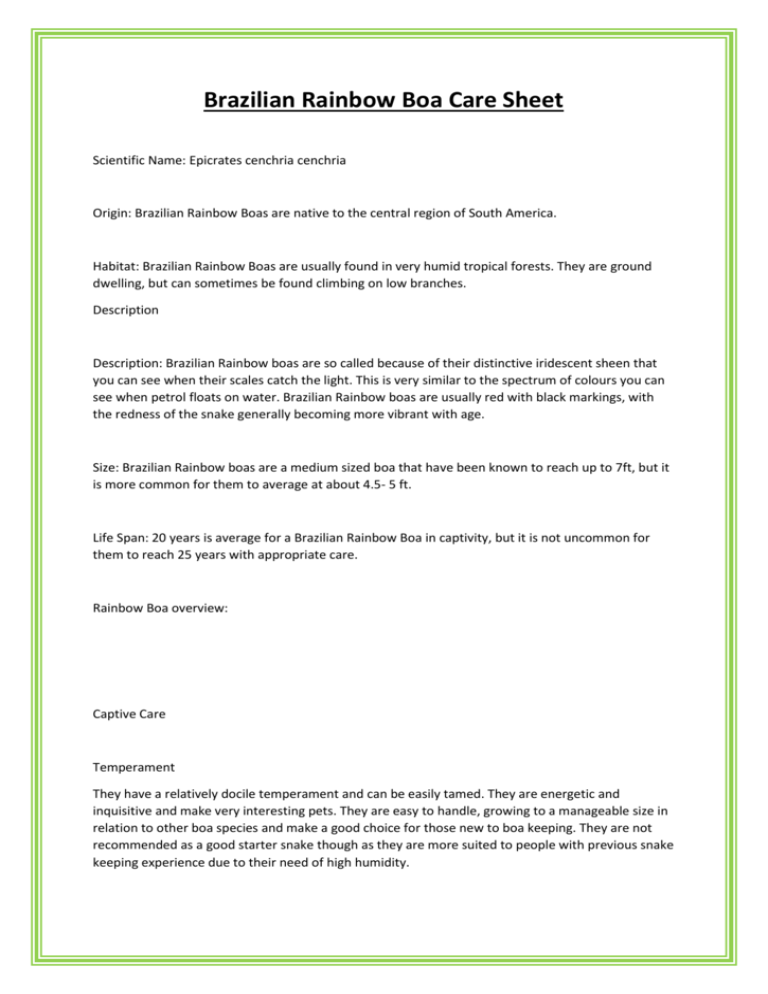HERE - esras
advertisement

Brazilian Rainbow Boa Care Sheet Scientific Name: Epicrates cenchria cenchria Origin: Brazilian Rainbow Boas are native to the central region of South America. Habitat: Brazilian Rainbow Boas are usually found in very humid tropical forests. They are ground dwelling, but can sometimes be found climbing on low branches. Description Description: Brazilian Rainbow boas are so called because of their distinctive iridescent sheen that you can see when their scales catch the light. This is very similar to the spectrum of colours you can see when petrol floats on water. Brazilian Rainbow boas are usually red with black markings, with the redness of the snake generally becoming more vibrant with age. Size: Brazilian Rainbow boas are a medium sized boa that have been known to reach up to 7ft, but it is more common for them to average at about 4.5- 5 ft. Life Span: 20 years is average for a Brazilian Rainbow Boa in captivity, but it is not uncommon for them to reach 25 years with appropriate care. Rainbow Boa overview: Captive Care Temperament They have a relatively docile temperament and can be easily tamed. They are energetic and inquisitive and make very interesting pets. They are easy to handle, growing to a manageable size in relation to other boa species and make a good choice for those new to boa keeping. They are not recommended as a good starter snake though as they are more suited to people with previous snake keeping experience due to their need of high humidity. Brazilian Rainbow Boas are not likely to bite as adults, but hatchlings and juveniles are notorious for being a little nippy. Regular handling should calm your young boa down in time and it should not be a problem. Adult Brazilian Rainbow Boa being handled Handling Brazilian Rainbow Boas are quite active snakes and will appreciate time outside the vivarium to exercise. Brazilian Rainbow boas are nocturnal, so will generally be more active at night, so this is a good time to handle your boa. In adulthood your Brazilian Rainbow Boa will be quite large so should be handled with care. They are extremely muscular and can grip on very tightly, but they should be easy to un-wind if you are uncomfortable. Hatchling Rainbow Boas are known to be a little nippy, but will soon calm down with regular handling and as they age. Feeding Rat Pup- suitable for hatchling Rainbow Boas Medium Mouse- suitable for Juvenile Rainbow Boas Large Mouse- Suitable for Yearling Rainbow Boas Large Weaner Rats- Suitable for adult Rainbow Boas Hatchlings start on fuzzy mice or rat pups, one every 5-6 days and graduate up to adult mice or a large weaner rat every 7-8 days as they grow. Many Rainbow Boa keepers would recommend that a hatchling Rainbow Boa should be introduced to rats at an early age, as it may be harder to offer rats once your rainbow boa is established on mice. Rats are a larger prey item than mice, so it is a more appropriate size for feeding to an adult than multiple mice. Do not feed your snake with live food, even a small mouse may bite or injure your snake. Shop brought frozen rodents are available from most pet shops or bought over the internet these can be thawed to room temperature and make an excellent all round food for your snake. Wild rodents carry parasites and should be avoided at all times. Rainbow Boas, like all boids have sensory organs called heat pits, which greatly help them to find the radiant heat of their prey. It is useful to try and reheat your thawed rodent before offering it to your Rainbow Boa. One method is to place your rodent in a sandwich bag and lower into hot water for a few minutes. Never handle your snake straight after a feed, as it will regurgitate its meal. It is recommended to leave for at least 48 hours before handling. Be aware that Rainbow boas can sometimes become obese in captivity. Regular monitoring of your Rainbow Boas weight will allow you to regulate the feedings accordingly. Shedding Brazilian Rainbow Boas, like all other snakes, shed their outer layer of skin periodically throughout their lives. Young snakes may shed more frequently than adult snakes, but in general the shedding process occurs several times a year. This is nothing to worry about as a keeper, but there are a few things you can do to help your snake through this process. Preecdysis is the name given to the changes your snake will go through whilst preparing to shed its skin. This will include a dulling of your snake's skin colour, general inactivity and their eyes will turn a bluish grey colour. At this time your hognose may refuse a feed or shy away from being handled, but this depends on the individual snake and how they handle preecdysis. While your snake is 'in blue' it is advisable to handle with care as their vision is obscured by the membrane covering its eyes and they may feel more insecure than usual, therefore more likely to be defensive. Ecdysis is the act of shedding, which is usually started by your snake rubbing it's head on rocks or decor to loosen the skin around its head. Once it has worked its head free it will continue to crawl its way out of the old skin by rolling it inside out has it moves. Once your snake has shed its skin it should be removed from the vivarium along with any faeces that usually accompanies Ecdysis. Check your snake to ensure that the shed skin has successfully been removed, taking particular notice that the eye caps and tail end have not been retained. If necessary bathe your snake and remove any patches of skin that have not been shed with a warm towel or tweezers, to avoid infection or death of the tissue below it. Housing Brazilian Rainbow Boas are quite active, but do not need huge enclosures. A medium to large sized vivarium (Even a fish tank with a tight fitting lid) will house your Rainbow Boa nicely. Glass vivariums are more suitable for Rainbow Boas due to the high humidity required. The vivarium should allow a minimum of 1 square foot of floor space to each foot of snake and be approximately a third of the snake’s length in height. Hatchlings should start out in an appropriately sized small vivarium or RUB (Really Useful Box) as they can become stressed and stop feeding in an oversized vivarium. All Snakes are excellent escape artists, so care must be taken when planning their housing. Make sure your vivarium or tank has a tight fitting lid, which can be clamped down. Brazilian Rainbow Boas are very strong and can push a loose fitting lid from a vivarium. Brazilian Rainbow Boas need to maintain a high humidity within their vivariums, so a glass tank or RUB (really useful box) may be more appropriate than a wooden vivarium. Wood tends to warp under the excess of moisture and mould and decay can be a problem. Brazilian Rainbow Boas will require their housing to be completely cleaned out on a weekly basis, due to the mould and bacteria build up caused by the high humidity. Your Brazilian Rainbow Boa's Vivarium Should Contain: Substrate Eco-Earth - a suitable substrate for Brazilian Rainbow Boas Orchid Bark - a suitable substrate for a Brazilian Rainbow Boa Hydroleca Balls - a good way to keep the humidity high for your Brazilian Rainbow Boa Newspaper - a suitable substrate for Brazilian Rainbow Boas There are various substrates you can choose to use in your Brazilian Rainbow Boa's Vivarium: Orchid Bark Is a commonly used substrate for Rainbow Boas because it helps to retain moisture, which is useful for maintaining the humidity required within the vivarium. Peat-Bark Mix Also retains a good humidity level, but is more in keeping with the Rainbow Boas natural environment in the wild. Cypress mulch This substrate is a good choice for high humidity vivariums, because it resists mould and decay. Eco-Earth Can be bought in block form and it expands in water to make a rich, reptile safe soil bedding. Hydroleca Balls This is not really a substrate, but these water retaining balls can be used under the substrate to help keep the humidity up. Newspaper Is a cheap and easy to change substrate Heating Equipment Heating equipment for your Rainbow Boa Brazilian Rainbow Boas are cold blooded and get heat from their surroundings. In the wild snakes bask in the sun to keep warm or move to a shady spot if they are too hot, this is called thermo-regulation. The ideal temperature for you snake's vivarium is a temperature gradient of 21-30°C (70-86°F). Heat should be provided using either a heat mat with thermostat, a ceramic heater with pulse thermostat and bulb guard or a normal light bulb with a dimming stat on the roof of the vivarium surrounded by a bulb guard. Heat mats are more suited to smaller/younger snakes and should only cover between a third and a half of the floor space to allow your snake to thermo-regulate. This heat mat should be regulated by a thermostat to ensure that it does not overheat. Since a heat mat should provide sufficient heat to keep your Rainbow Boa happy, a basic mat stat, like the Microclimate Ministat 100 or the Habistat Mat Stat, should be appropriate. These thermostats are available from reptile shops and online, are relatively cheap, and will ensure the heat source is regulated at a safe level. For larger adult Rainbow Boas a ceramic bulb or heater is more advisable, due to the risk of thermal blocking (Where the sheer weight of a large bodied snake causes hot spots on the heat mat due to the heat reflecting back from the vivarium floor and into the snake). Thermal blocking can cause severe burns when heat mats are used inside the vivarium. Heat mats do have their place if used under a RUB (Really useful box) or in a stack system, but MUST be used with a mat stat. Thermal blocking can even cause glass vivarium’s to crack or shatter (Even when used with a thermostat), which can cause serious damage if your snake comes into contact with the sharp glass. I would highly recommend a Ceramic bulb (with appropriate guard) and pulse thermostat for this reason and because they keep more accurate temperatures than most other heating methods. A popular alternative to the heat mat is a normal light bulb on the roof of the vivarium surrounded by a guard. Rainbow Boas do not feel heat in the same way that we do and do not always realise that something they are touching is burning them. A bulb guard will ensure that your Rainbow Boa will stay a safe distance away from the heat of the bulb so burns will be avoided. Using a low wattage bulb means the tank will not over heat. The bulb also gives light for the owner to see their snake as well as heat for the snake. Extra care should be taken if you choose to use a bulb in your Brazilian Rainbow Boa's vivarium, due to the high humidity that will be needed within the tank. A ceramic bulb can be purchased from most reptile shops and is a good heat source for Rainbow Boas as it raises the ambient air temperature of the vivarium. Ceramic heaters must be used with both a pulse thermostat and a bulb guard. They can reach high temperatures and you should check the wattage of the ceramic before purchasing, as the wattage of the ceramic is dependent on the size of the vivarium you are trying to heat. Ceramic bulbs last longer than normal light bulbs and do not cause light-stress. It's useful when using both methods to have a small thermometer on either end of the vivarium to check the temperature. Place the thermometers near the hides on top of the substrate as this is where your Rainbow Boa will spend the majority of its time. One end should be around 21°C and the other around 30°C. Checking temperatures regularly is advised to ensure that your Rainbow Boa can thermo-regulate by moving around the tank. A Place for your Brazilian Rainbow Boa to Hide A range of hides that are suitable for use with a Brazilian Rainbow Boa All Brazilian Rainbow Boas need somewhere to hide and may become stressed if this is not provided. This could be a cardboard box with a hole cut into it, which can be easily replaced if it becomes soiled or begins to decay. Flower pots also make good hides for Brazilian Rainbow Boas. Specialist reptile hides can be purchased from pet shops and over the Internet. These can be cleaned when you clean the rest of the vivarium once a week. Any hide should be just large enough for your Brazilian Rainbow Boa to curl up in; if it is too large the snake will not feel as secure. In general, it is wise to place three hides in your vivarium for your Brazilian Rainbow Boa to use, one in the warm side of the vivarium and one in the cooler side and one should be a damp hide. This enables your snake to have adequate hiding places along the temperature gradient, which would allow your snake to adjust its body temperature. This is important, because for some Brazilian Rainbow Boas, the instinct to hide is often more insistent than the instinct to keep at the right temperature. If the snake does not control his body temperature it can lead to many problems, the least of which being digestive problems. A Place to Climb Branches and plastic plants can be bought from pet shops and over the internet these provide a place for climbing and resting, they also aid the snake when shedding its skin. Brazilian Rainbow Boas appreciate being able to climb, as it will keep them active and provide vital exercise. Branches collected from the wild will need to be debugged by soaking first in chlorine/water solution, then rinsed thoroughly, soaked in clean water, then left to dry in the sun. Some live plants may be harmful to your Brazilian Rainbow Boa, if in doubt don't use them in your Vivarium. A Change of Scenery Brazilian Rainbow Boas are very inquisitive animals and like to explore new surroundings. Once in a while change the layout of the Vivarium; this will keep your Brazilian Rainbow Boa from becoming bored. You will notice once you put your snake back in the tank it will start to re-explore its new surroundings. Water Bowl All Brazilian Rainbow Boas need fresh water to drink daily. Water should be given in a large sized bowl which is fairly heavy to stop your snake tipping it over. The water bowl is vital for helping keep the humidity levels up. If possible, provide a water bowl with a large surface area and place in the warm side of the vivarium. Water can also help your snake during shedding at this time your snake may be found bathing in the water. If the snake defecates in its water bowl, the bowl must be cleaned and disinfected immediately. Humidity Hygrometers are humidity gauges which are vital for monitoring the correct humidity with a Rainbow boa enclosure Most Brazilian Rainbow Boas require very high levels of humidity. Hatchling and young Rainbow Boas should be kept in conditions of 80 plus humidity, but adults can handle it a little lower than that. Aim for around 75-80 in adults, but a little more is better than less. Rainbow Boas can dehydrate if the humidity levels are not maintained, so it is very important to have an accurate Hydrometer to monitor the humidity. Rainbow Boas cannot handle humidity of less than 50%, as they are likely to dehydrate at this level. There are a few ways of maintaining the correct humidity. One of these is to place the water bowl in the warm side of the vivarium. The bowl should have a large surface area to enhance the ability of evaporation. You should also mist your vivarium a few times a day with water from a spray bottle. A damp hide is another good way of maintaining the humidity. This can be a bought hide made for the purpose or simply a plastic sandwich box with a hole cut into the lid. Fill this hide with damp sphagnum moss, so that your Rainbow Boa always has a place to retreat if the humidity drops too low for them. Breeding Brazilian Rainbow Boas should be of a good age and weight before they are allowed to breed to avoid problems. I would recommend that the minimum requirements for a female to breed would be at least 3 to 4 years of age, 5ft in length and 1400 grams in weight. Brazilian Rainbow Boas are oviviparous. Sexing Brazilian Rainbow boas can be probed to determine sex, but this should only be done by an experienced keeper or vet. Males tend to have larger spurs near the entrance to their vent, but this is not a 100% accurate way to determine sex. Brumation Brumation (cooling your snake down for winter) is not always necessary for successful breeding, as some breeders find that they have better results from shortening the light period rather than lowering the temperature. If you do decide to lower the temperature, only drop it by a few degrees at night time. This mimics the cooling down that Rainbow Boas experience in the wild and does not affect the humidity levels too much. A good brumation period is about 6 to 10 weeks. The temperature needs to be dropped gradually at night-time and maintained until gradually raising it back up after the recommended brumation period. Mating In the wild the Rainbow Boa mating season is usually February to June, so this is a good time to introduce your male to the female’s vivarium for copulation. They can be left together for a few weeks. If the copulation is successful, the female will become gravid (pregnant). Rainbow Boas actually have two seasons and can be mated in the autumn for hatchlings in the spring. Gravidity Females may go off their food whilst being gravid, but should still be offered small prey items just in case. Gestation averages at about 5 months, with females becoming increasingly large at the back end of their bodies. Do not disturb your female while she is giving birth to the hatchlings, as this could upset her and increase your chances of still borns. Remove the hatchlings as soon as they are born to avoid the mother mistaking them for unfertilized slugs and eating them. Hatchlings Hatchlings will require their first feed a week after their first shed, which should be around a fortnight after birth. They tend to be a little nippy at this stage, so regular handling is needed to help tame them down. Common Complaints Rainbow Boas are a hardy snake that would rarely become ill with appropriate care, but here is a quick introduction to a few disorders that need to be looked out for. Snake mite hiding under the scales. Mites: Mites are little black parasites that live on your Rainbow Boa and feed on their blood. If your Rainbow Boa catches mites they can usually be found around the eyes, mouth and under scales. Your snake will seem lethargic and may go off its food during a mite infestation. If you discover mites on your Rainbow Boa, immediately bathe your snake in warm water and fully disinfect the entire tank and contents. Refill your vivarium with white kitchen roll and leave the cage furniture to a minimum. This helps stops the mites being able to breed as they need substrate to lay eggs and also allows you to see them more clearly while you monitor your snake. Repeated bathing and disinfecting of the vivarium helps, but it unlikely that you will remove a mite infestation without some sort of treatment. Reptile shops sell various treatments to help kill off the mites, but some vets may prescribe a weak dose of Frontline if they feel it is necessary. Respiratory Infections (R.Is): R.Is are a bacterial infection that is usually caused by poor cage conditions, low temperatures or too much humidity, but can be passed from snake to snake too. Rainbow Boas may sound wheezy with excessive saliva and nasal discharge. Their mouths may also gape open as your Rainbow Boa struggles to breathe. Very mild R.Is may go away themselves if the conditions that the snake are living in are corrected, but serious infections need to be seen to by a vet immediately to avoid Mouth Rot or even death of your Rainbow Boa. The vet may prescribe an anti-biotic called Baytril, which is safe enough to be given to your snake. Regurgitation: When a snake regurgitates it's meal, it may not necessarily be down to illness, but as regurgitation is a symptom of many digestive problems, illnesses and stress it is recommended that if your Rainbow Boa does regurgitate it's meal that you monitor your snake very closely for further symptoms. Sometimes a Rainbow Boa may regurgitate its meal if it is handled too soon after a feeding or if it has been fed an item that is too large for it. In this case, you should leave the snake to settle back down for a week before trying to feed again. If your Rainbow Boa repeatedly regurgitates its meal, loses excessive weight or shows any other signs that are worrying you, seek medical attention as soon as possible.



![Rainbow Sandals[1]](http://s2.studylib.net/store/data/005415944_1-86d746c06518ebd8de8a03e56a4931b4-300x300.png)




